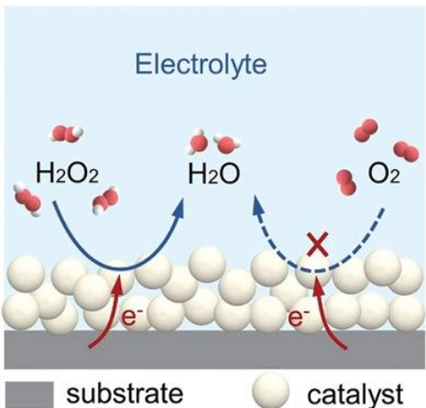Oxygen Vacancy-Mediated Catalysts toward Selective H2O2 Reduction in Cellular Environment
Zhenyao Ding1, Dandan Wang1, Liping Chen1, Huijun Yu2, Hang Zhou1, Yifan Zhou1, Xinjian Feng1,3*(封心建), Lei Jiang4
1 Soochow Univ, Coll Chem Chem Engn & Mat Sci, Suzhou 215123, Peoples R China
2 Soochow Univ, Suzhou Med Coll, Sch Biol & Basic Med Sci, Suzhou 215123, Peoples R China
3 Soochow Univ, Innovat Ctr Chem Sci, Suzhou 215123, Peoples R China
4 Chinese Acad Sci, Tech Inst Phys & Chem, Key Lab Bioinspired Mat & Interfacial Sci, Beijing 100190, Peoples R China
Adv. Funct. Mater. 2022, 2210674
Abnormal hydrogen peroxide (H2O2) levels in the cellular environment are closely related to cell dysfunction and serious diseases. Thus, selective and sensitive H2O2 detections are urgently needed for clinical diagnosis and therapy. Herein, via surface defect engineering, an oxygen-tolerant electrocatalyst based on tin oxide for selective H2O2 reduction and detection with exceptional stability and activity is designed and developed. When introduced at an appropriate level (≈5.3%), surface oxygen vacancies help lower the charge transfer resistance for enhancing the H2O2 reduction reaction, while maintain the weak oxygen (O2) adsorption, which enables a constant H2O2 reduction (sensing) response in the electrolyte at variable oxygen levels. Moreover, the tin oxide-based assay system exhibits outstanding stability over a wide pH range of 4-9, as well as selectivity in the presence of interferent endogenous and exogenous electroactive species, which is suitable for trace H2O2 monitoring secreted from NB4 cells, a model cancer cell. The oxygen vacancy-mediated tin oxide achieves the highest stability as well as high selectivity compared to reported electrochemical probes for specific H2O2 detection in biological environments, with the potential for biological and biomedical applications.

链接://onlinelibrary.wiley.com/doi/full/10.1002/adfm.202210674